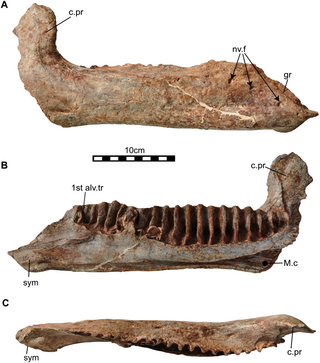Ferugliotheriidae is one of three known families in the order Gondwanatheria, an enigmatic group of extinct mammals. Gondwanatheres have been classified as a group of uncertain affinities or as members of Multituberculata, a major extinct mammalian order. The best-known representative of Ferugliotheriidae is the genus Ferugliotherium from the Late Cretaceous epoch in Argentina. A second genus, Trapalcotherium, is known from a single tooth, a first lower molariform, from a different Late Cretaceous Argentinean locality. Another genus known from a single tooth, Argentodites, was first described as an unrelated multituberculate, but later identified as possibly related to Ferugliotherium. Finally, a single tooth from the Paleogene of Peru, LACM 149371, perhaps a last upper molariform, and a recent specimen from Mexico, may represent related animals.

Fukuiraptor was a medium-sized megaraptoran theropod dinosaur of the Early Cretaceous epoch that lived in what is now Japan. Fukuiraptor is known from the Kitadani Formation and possibly also the Sebayashi Formation.

Fukuisaurus is a genus of herbivorous ornithopod dinosaur that lived during the Early Cretaceous in what is now Japan. The type species is F. tetoriensis, which was named and described in 2003.

The Fukui Prefectural Dinosaur Museum, located in Katsuyama, Fukui, Japan, is one of the leading dinosaur museums in Asia that is renowned for its exhibits of fossil specimens of dinosaurs and paleontological research. It is sited in the Nagaoyama Park near the Kitadani Dinosaur Quarry that the Lower Cretaceous Kitadani Formation of the Tetori Group is cropped out and a large number of dinosaur remains including Fukuiraptor kitadaniensis and Fukuisaurus tetoriensis are found and excavated.

Gobiconodon is an extinct genus of carnivorous mammals belonging to the family Gobiconodontidae. Undisputed records of Gobiconodon are restricted to the Early Cretaceous of Asia and North America, but isolated teeth attributed to the genus have also been described from formations in England and Morocco dating as far back as the Middle Jurassic. Species of Gobiconodon varied considerably in size, with G. ostromi, one of the larger species, being around the size of a modern Virginia opossum. Like other gobiconodontids, it possessed several speciations towards carnivory, such as shearing molariform teeth, large canine-like incisors and powerful jaw and forelimb musculature, indicating that it probably fed on vertebrate prey. Unusually among predatory mammals and other eutriconodonts, the lower canines were vestigial, with the first lower incisor pair having become massive and canine-like. Like the larger Repenomamus there might be some evidence of scavenging.

The Kitadani Formation is a unit of Lower Cretaceous sedimentary rock which crops out near the city of Katsuyama in Fukui Prefecture, Japan, and it is the primary source of Cretaceous-aged non-marine vertebrate fossils in Japan. Dinosaur remains are among the fossils that have been recovered from the formation, but it also preserves a diverse assemblage of plants, invertebrates, and other vertebrates. Most, if not all, of the fossil specimens collected from the Kitadani Formation are reposited at the Fukui Prefectural Dinosaur Museum.
The Amagodani Formation is an Early Cretaceous geologic formation in Japan. An indeterminate iguanodontian tooth has been recovered from the formation. as well as indeterminate pterosaur remains. Dinosaur footprints are also known from the formation.
The Kuwajima Formation is an Early Cretaceous geologic formation in Japan. Its precise age is uncertain due to a lack of identifying fossils, and it was previously considered likely Valanginian to Hauterivian in age. However, it is now considered to probably be Barremian in age. Dinosaurs and other vertebrates has been recovered from the Kaseki-kabe "Fossil-bluff" locality in the uppermost part of the formation.
The Akaiwa Formation is an Early Cretaceous (Hauterivian-Barremian) geologic formation in central Honshu, Japan. Indeterminate ornithischian fossils are known from the formation. Fossil ornithopod tracks have been reported from the formation. As well as the turtle Kappachelys

Fukuititan is a genus of titanosauriform sauropod dinosaur that lived in the Early Cretaceous in what is now Japan. It is known from FPDM-V8468, the associated partial skeleton of a single individual, recovered from the Kitadani Dinosaur Quarry of the Tetori Group, at Katsuyama City. The type species, Fukuititan nipponensis, was described in 2010 by Japanese scientists Yoichi Azuma and Masateru Shibata of the Fukui Prefectural Dinosaur Museum. The discovery sheds light on Japanese titanosauriforms, which are poorly known in the region.
The Khok Kruat Formation is a rock formation found in northeastern Thailand. It is the uppermost formation of the Khorat Group. It is dated to the Aptian stage of the Early Cretaceous period, and is notable for its fossils of dinosaurs. It is equivalent to the Gres superieurs Formation of Laos. The group is a fluvial formation consisting primarily of red siltstones and sandstones.
Dongyangopelta is an monospecific genus of nodosaurid dinosaur that lived in China during the Early to Late Cretaceous period in what is now the Chaochuan Formation. The type and only known species, Dongyangopelta yangyanensis, is known from a partial postcranial skeleton preserving osteoderms and ossified tendons. It was named in 2013 by Rongjun Chen, Wenjie Zheng, Yoichi Azuma, Masateru Shibata, Tianling Lou, Qiang Jin and Xinsheng Jin. Dongyangopelta represents one of the only nodosaurids known from Asia, along with Taohelong and Sauroplites.

Koshisaurus is a monospecific genus of basal hadrosauroid from the Kitadani Formation in Japan. The discovery of the genus suggests that hadrosauroids had higher diversity along the eastern margin of Asia in the Early Cretaceous. "Koshi" means an old Japanese regional name including Fukui prefecture where fossils of the genus were discovered.

Sirindhorna is a genus of hadrosauroid ornithopod dinosaur from Early Cretaceous deposits of northeastern Thailand.

Fukuivenator is an extinct genus of therizinosaurian theropod dinosaur from the Early Cretaceous of Japan.
Nipponoolithus is an oogenus of fossil egg native to Japan. It is one of the smallest known dinosaur eggs, and was probably laid by some kind of non-avian maniraptor.
Plagioolithus is an oogenus of fossil egg. It is from the Early Cretaceous of Japan. It was probably laid by a bird, making it the oldest known fossil bird egg.
The Liangtoutang Formation, also referred to as the Laijia Formation is a geological formation located in Zhejiang, China. Its strata date back to the Albian to Cenomanian stages of the Cretaceous period. The lithology primarily consists of red sandstone.

Fukuipteryx is an extinct genus of basal avialan dinosaurs found in Early Cretaceous deposits from Japan's Kitadani Formation. It contains one species, Fukuipteryx prima.

Tyrannomimus is an extinct genus of ornithomimosaurian theropod dinosaurs from the Kitadani Formation of Japan. The type species is Tyrannomimus fukuiensis.















